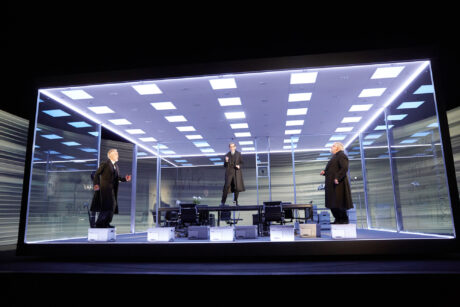
LONDON – Starting out at the National Theatre’s Lyttelton before transferring to New York’s Park Avenue Armory, The Lehman Trilogy returned to London for a 15-week run at the Piccadilly Theatre. Space constraints at the new venue instigated a move from projection to LED – a challenge that was answered with a video design from Universal Pixels.
More details from Universal Pixels (www.unipix.tv):
The production, adapted by Ben Power from Stefano Massini’s original play and directed by Sam Mendes, tells the story of how the three Lehman brothers (played by actors Adam Godley, Ben Miles and Simon Russell Beale) voyaged across the Atlantic in the mid-1840s before revolutionizing banking against the ever-changing backdrop of modern America. Lehman Brothers Holdings Inc, by then a global financial services firm, famously filed for bankruptcy in 2008 – sending the world’s financial system into meltdown.
Es Devlin’s stunning set, with its minimalist glass and revolving box design, provided the vehicle for the century-spanning tale. Luke Halls’ powerful video design provided movement and motion, shifting the context through environments and time – from the cotton fields of Alabama to modern-day New York.
With projection ruled out due to the size constraints of the Piccadilly Theatre, Halls looked to the option of LED – initially with a degree of trepidation. Halls said: “LED is a very different technology and the show does all of the things that you shouldn’t really do on LED, like long dissolves between grey and black, and all that stuff. It was a bit of a challenge transforming the show over to that, but it also gave us a lot of brightness that we didn’t have before.”
Halls contacted Universal Pixels co-founder Ollie Luff, who offered technical advice and reassurances that a viable solution was possible. Luff explained: “Cost was a real pressure on this show, but fortunately we had a generous timeframe as discussions started well over a year prior to load in. We were able to combine both a cost effective off the shelf solution with custom-fabricated metal brackets to achieve a precise 4.1-degree angle specifically for the Piccadilly Theatre.”
The screen was constructed using 190sqm of Leyard CF0 3.9mm panels set into a custom curved structure. The exact 4.1-degree angle of the screen was fundamental to maximising the screen size in the available space.
Luff added: “Other LED products are fixed to pre-determined angles, but with the combination of the Leyard screen and our custom engineering department we were able to give Luke and [production manager] Jim Leaver exactly what they wanted.
“The Leyard screen was the only way to deliver such a large screen with the necessary resolution in the classic weight restricted venues of the West End. At just 22kg per sqm, the Leyard 3.9mm really is a game changer, making high resolution LED in a large format truly accessible to theatre. The whole screen still came in at nearly six tonnes as it was a whopping 28m wide and 6m high., making it the largest single continuous screen ever installed into a West End Show.”
Halls commented: “Universal Pixels gave us a good quality product, which we were able to play around with and achieve the result we wanted. It’s always been a pleasure working with them. They make everything very seamless and easy and are always on hand with good quality support.”
The Lehman Trilogy premieres on Broadway next year.
Photo by Mark Douet


